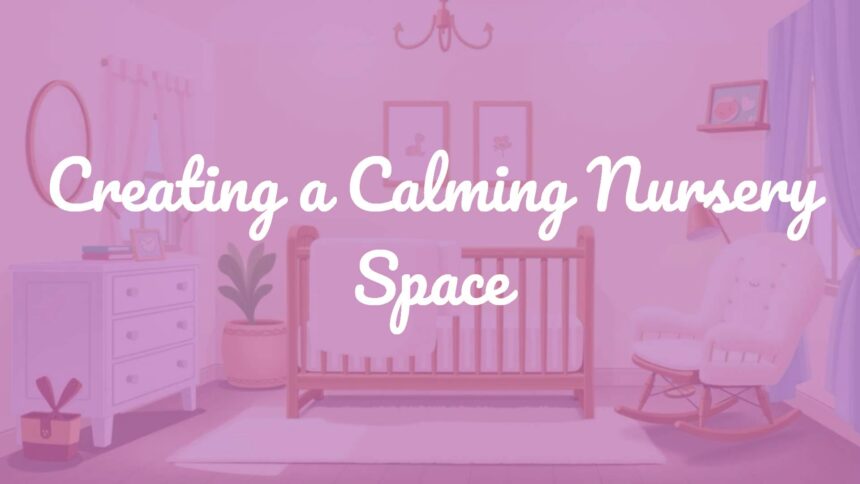Designing a soothing nursery is about more than just picking out decorations-it’s about making a cozy space where babies and parents both feel comfortable and calm. This special room becomes a safe place for bonding, feeding, playing, and, most importantly, sleeping. Every decision-from the color on the walls to where the crib goes-can affect your baby’s mood and sleep, while also giving parents a peaceful area during those long nights. Here’s a clear guide to making a nursery that helps your baby relax and grow, making sure it’s a space that feels peaceful for everyone.
Why a Calming Nursery is Important
The nursery isn’t just any room; it’s the first important space your baby spends a lot of time in, and it can shape how they feel and grow, as well as help the whole family feel more comfortable. A calm nursery serves as a retreat from the busy outside world and offers a steady place for everyday activities.
How the Nursery Impacts Sleep and Wellbeing
Babies notice everything around them, so their room can strongly affect their rest and how secure they feel. A soothing space helps them settle down and sleep better, while a cluttered or bright room might leave them restless. Soft colors, gentle lights, and an uncluttered room all play a part in making a peaceful setting. Pediatricians, like Dr. Harvey Karp, say that while lively colors encourage learning, soft shades help the brain relax, which is needed for good sleep. This balance lets babies feel safe and relaxed, much like the womb, supporting healthy development.
The Benefits for Parents and Family
The nursery is not only for the baby-parents spend many hours here, too. A comfortable chair, soft lighting, and an organized room can make nighttime feedings or diaper changes much easier. A calm setting can lower stress and help parents stay more relaxed, making it easier to bond with the baby and get much-needed rest. When the room feels peaceful, everyone benefits and daily life with a newborn becomes less stressful and more joyful.

Picking the Right Color Palette
The wall color and overall room palette set the tone for the nursery. This is more than picking your favorite color-it’s about creating a setting that helps everyone feel calm and ready to rest.
Colors for a Relaxed Nursery
- Soft Greens
- Light Blues
- Warm Neutrals (cream, beige, gray)
- Muted Pastels
Paint with gentle hues rather than bright, bold ones. Light blue help brings a serene mood, and soft lavenders or muted pinks can make the space inviting. It is best to avoid strong yellows or reds, which can be too stimulating for a sleeping area.
Ideas for Gender-Neutral and Timeless Color
To make the nursery last through early childhood, pick basic colors that work for any child-shades like white, gray, or beige. If you want some color, try star or watercolor wall patterns or use removable decorations. Add brighter touches through pillows, blankets, or toys, so you can easily change the look later. This way, the nursery can stay soothing but also grow with your child.

Using Soft Light for Calmness
The right lighting helps make a peaceful nursery. Instead of harsh ceilings lights, use soft lamps or dimmable bulbs to create a gentle glow for sleeping and night feedings.
Good Lighting Options for Babies
- Table lamps with soft bulbs
- Dimmable wall lights near your chair
- Nightlights with amber or red tones (instead of pure white or blue)
During the day, let natural light in, but at night keep things dim to encourage sleep for both baby and parents.
Why Use Blackout Curtains and Dimmable Lights?
| Feature | What it Helps With |
|---|---|
| Blackout curtains | Block daylight, help with naps, keep the room dark for sleeping |
| Dimmable lights | Create soft, restful lighting at night, support sleep routines |
Together, they help you control the room’s brightness so your baby sleeps better any time of day.
Choosing Nursery Furniture That’s Comfortable and Useful
It’s important that nursery furniture isn’t just good-looking-it needs to be safe, comfortable, and useful for daily life.
Keeping the Crib Safe and in a Good Spot
- Buy a crib that meets safety standards
- Place the crib away from windows, cords, and outlets
- Secure any attached baskets or storage firmly
- Anchor dressers and shelves so they can’t tip over
How to Pick a Cozy Chair or Rocker
You’ll spend plenty of time sitting in the nursery, so choose a chair that is soft, has good arm support, and is deep enough for comfort. If there’s space, a chair that doubles as a fold-out bed is handy for overnight stays. Add a blanket and a pillow for extra coziness.
Ideas for Storage and Changing Areas
- Use a sturdy dresser that can hold a changing pad on top
- Try portable storage baskets for diapers and wipes
- Add slim wardrobes or tall chests for clothes
- Use baskets or shelves for books and toys
Look for items that can be repurposed as your child grows, such as baskets that can be used for toys later.

Adding Soft Textures for Comfort
Textures make the nursery feel cozy. Different materials-like rugs, blankets, or natural wood-add warmth and make the space comfortable for everyone.
Ways to Add Softness
- Use a low-pile or plush rug that’s easy to clean
- Keep a soft baby blanket handy
- Choose organic cotton or wool for bedding and curtains
Using Natural Materials
Add natural touches with wood or woven baskets. Wooden furniture is sturdy and looks classic. Rattan or seagrass baskets can store toys or laundry and also add a textural element to the room. Small wooden toys or mobiles can complete the natural look, making the room both gentle and inviting.
Keeping Clutter Away for a Peaceful Space
A tidy room feels more calm. Limiting the amount of stuff in the nursery makes it easier to keep things organized and less overwhelming for tired parents.
Simple Ways to Cut Down Clutter
- Stick to the basics: crib, changing area, and only the storage you need
- Rotate toys and books rather than displaying everything at once
- Put away stimulating items during rest time
Organizing Baby Essentials
- Use labeled baskets for diapers, toys, and supplies
- Add closet organizers or storage bins under the crib
- Keep frequently used items within reach
Having a dedicated spot for each item makes cleanup quick and helps you keep a calm setting.
Bringing in Gentle Sounds and Scents
The nursery isn’t just about what you see; what you hear and smell matters too. Soft sounds and light, natural scents can help babies (and parents) relax.
Using White Noise and Music
- White noise machines can cover up house sounds and make sleep easier
- The Baby Shusher and similar tools mimic comforting sounds
- Soft lullabies or gentle music also work well
Keep sounds steady and quiet instead of sudden or loud.
Handling Scents Safely
- Avoid strong fragrances, air fresheners, or oil diffusers
- If you use scent, try a mild lavender sachet out of reach
- Choose baby-safe laundry detergent with a light scent
- Make sure the room has plenty of fresh air
Check with your doctor before using essential oils, and don’t put them close to your baby.
Making the Nursery Peaceful for Everyone
A nursery should comfort both your baby and you. Setting it up so that night care and bonding are as simple as possible can make new parenthood a little easier.
Nighttime Care and Bonding Tips
- Keep a chair, dim light, and supplies like burp cloths or water close together
- Have a small table for your things by the chair
- Label baskets for diapers and wipes to make restocking easy
Tiny setup changes can make long nights easier and help everyone feel more at ease and connected.
Keeping Temperature and Air Quality Just Right
- Keep the nursery between 16-20°C (68-72°F)
- Use a room thermometer
- Open windows or use a fan in hot weather, but don’t let the fan blow right on baby
- Try a humidifier in dry seasons
These steps make sure your baby is comfortable, sleeps better, and stays healthy.
Keeping the Nursery Safe
Safety is the most important thing in any nursery. Everything you add-from the crib to the decorations-should be chosen with your baby’s safety in mind.
How to Avoid Common Dangers
- Anchor heavy furniture to the wall
- Keep cords out of reach or tucked away
- Use outlet covers
- Only use a safe, standard crib-no soft bedding or wide gaps
- Don’t hang heavy items over the crib
- Store small or breakable objects where babies can’t reach
Check the nursery regularly for new hazards as your child starts to move around more.
Choosing Non-Toxic Materials
- Use paints with low or no VOCs
- Pick real wood or furniture with safe finishes
- Choose bedding and curtains with organic or certified materials
This keeps the air cleaner and lowers the risk of chemical exposure for your baby.

Adding a Personal Touch
While calm and function are essential, your nursery should also feel personal and special to your family. Adding those extra details can make the room unique and meaningful.
Decor that Shows Your Family’s Story
- Use an heirloom baby blanket
- Hang art made by a family member or something with a personal theme
- Add a unique or personalized mobile
These special items bring warmth to the nursery and help create memories.
Heirlooms and Custom Touches
- Display family photos or a favorite passed-down toy
- Use classic or antique furniture pieces for style and history
- Always secure any important items out of baby’s reach
This makes the space feel both comforting and connected to your family’s history.
Planning for Your Baby’s Growth
Babies grow fast, and so will their needs in the nursery. It makes sense to set up the room so you can easily change it as your child gets older.
Designing for the Future
- Stick to classic wall and floor colors
- Change up the room with interchangeable accessories as your child’s interests change
- Use wall decals or new bedding instead of repainting every few years
This keeps your nursery useful for years to come.
Flexible Furniture and Decor
- Choose a crib that can turn into a toddler bed or daybed
- Pick a dresser that can later just be storage, not just a changing table
- Use storage baskets and shelves that work for babies and older children too
- Select walkers or baskets that help babies learn but can be used later for toys or storage
These ideas make sure your nursery grows and changes with your child, so you don’t need to redo everything every time your child enters a new stage.

